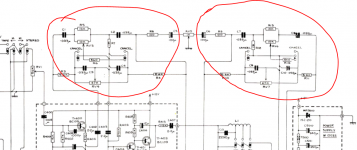This was the manual I was working to. The tone networks for each channel are shown ringed.
I would think the plumbers stuff should work but try it on something first to make sure it leaves no residue as it uses different chemicals (Di-methyl Ether) compared to traditional electronics freezer spray which is (or was last time I got some) HFC134A, the same 'gas' as used in air con systems. Cheap cans of 'compressed air' are mainly butane.
If you try a spray then you need to be able to dispense it literally a drop at a time onto the individual component. If you blast a whole area then everything gets chilled and you don't know which the faulty part is.
I would think the plumbers stuff should work but try it on something first to make sure it leaves no residue as it uses different chemicals (Di-methyl Ether) compared to traditional electronics freezer spray which is (or was last time I got some) HFC134A, the same 'gas' as used in air con systems. Cheap cans of 'compressed air' are mainly butane.
If you try a spray then you need to be able to dispense it literally a drop at a time onto the individual component. If you blast a whole area then everything gets chilled and you don't know which the faulty part is.
Attachments
and yet this piece of nearly 50year old gear was still working until recently.The quality of the PCBs in Quad gear was never very good. Have a good look for dry joints and verdigre.
Is this a motherboard and lots of daughter boards that slot in vertically?I don't think I have.
I have swapped around the two internal Amplifier PCBs and the fault has stayed on the same channel. This would suggest to me that the problem in not associated with either amplifier board.
If I am wrong, please explain.
If the channel remains in the same physical location after swapping daughter boards, then that points to the mother board and what supplies it, or comes out of it.
Does the 33 export music as soon as power ON and while the errant noises are being emitted?
Or is it silenced/muted with an electronic circuit for a short delay after start up?
Last edited:
My 33 & 303 are at least 35 years old. I would have thought that dry joints would have shown up some time ago.
Well the quality of the PCB doesn't affect dry joints, it's the quality of the soldering that does - and also the actual mechanical design.
I've repaired a fair few Quads over the decades, I don't recall ever having any dry joint problems? - most faults have been power amps (as you would expect), but the occasional faulty preamps have been duff transistors, or duff electrolytics.
- Status
- Not open for further replies.
